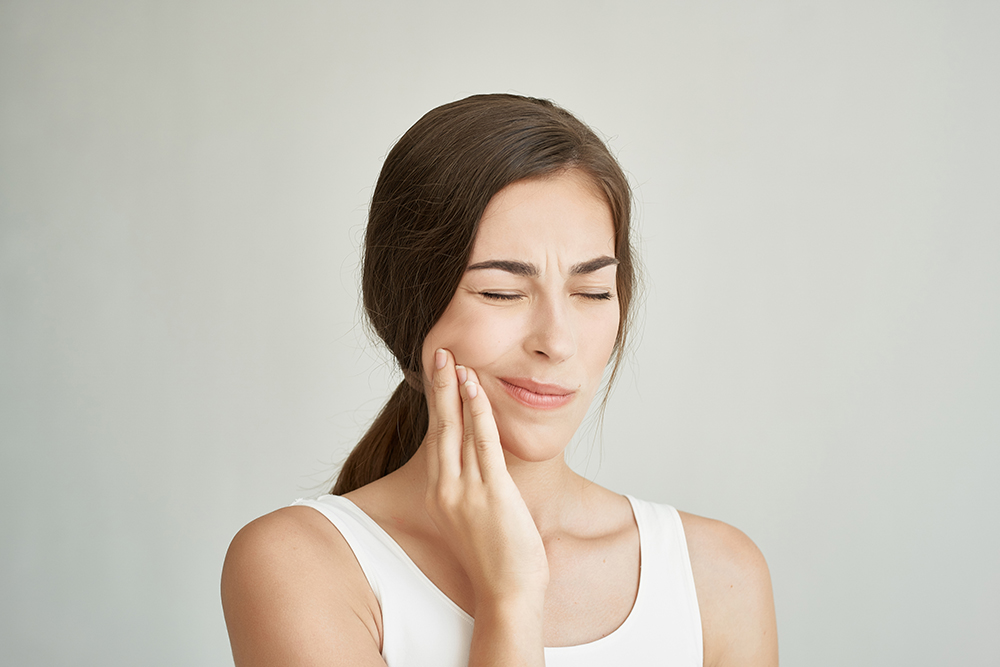Contents
Temporomandibular joint (TMJ) dysfunction is a painful and inconvenient condition that affects the temporomandibular joint in your jaw. Up to 12% of people deal with TMJ dysfunction in some form, from grinding and clenching to jaw lock.
Sometimes, mild TMJ dysfunction (TMJD) will go away on its own. However, if you’re dealing with TMJD that gets worse over time or won’t go away, physical therapy may help. Physical therapy is one of the most effective conservative treatments for TMJD. Whether you’re dealing with popping, tinnitus or headaches from your TMJD, physical therapy can address those issues. Don’t suffer unnecessarily with jaw pain. Let’s take a look at the treatments that can help.
Symptoms of TMJ disorders
TMJD can manifest in many ways, from headaches and jaw pain to an actual locking of the jaw. Since symptoms can be so widely varied, it’s important to know what to look out for. Here’s a list of some of the most common symptoms of TMJD to keep in mind:
- Pain or tenderness in your jaw.
- Pain in one or both of the temporomandibular joints.
- Pain that travels from the jaw to the temples, creating a tension headache.
- Aching pain in and around your ear.
- Difficulty chewing or pain while chewing.
- Pain that spreads to the face or neck.
- Jaw stiffness.
- Limited movement or locking of the jaw.
- Painful clicking, popping or grating in the jaw joint when opening or closing the mouth.
- Ringing in the ears, hearing loss or dizziness.
- A change in the way the upper and lower teeth fit together.
This isn’t a complete list of symptoms, and you may not experience everything on this list. But if you’re dealing with several of these symptoms, you may have TMJD. Talk to your doctor if you think you have TMJD to see what treatments they recommend.
Treatments for TMJ disorders
Because of the variety of symptoms that TMJD can cause, there isn’t always a one-size-fits-all solution to ease them. Manual therapy techniques are common for TMJ issues, but depending on what symptoms you’re dealing with, your physical therapist may recommend a slightly different treatment plan. Here are a few common TMJ issues and the types of treatments that may relieve them:
How to treat TMJ headaches
TMJ headaches can be caused by tension in the jaw that travels up to the temples. The temporomandibular joint directly connects the jaw to the skull, providing a direct path for the pain to travel along. Here are some physical therapy techniques that may help:
- Soft tissue manipulation — Soft tissue manipulation is a manual therapy technique that can increase blood flow and stimulate healing in the tissue surrounding the affected joint. This can relieve tension in the jaw, which in turn may reduce pressure in the temples.
- Joint mobilization — Joint mobilization targets the affected joint with slow, repetitive movements. The goal of this technique is to gently improve range of motion and reduce stiffness and pain within the jaw.
- Myofascial techniques — Myofascial release works the broader network of muscles that can cause pain and headaches. Massaging the myofascia in the face can relax the surrounding tissue and help relieve pain caused by TMJ headaches.
- Jaw exercises — If you improve the mobility around the jaw joint, you can reduce tension in the jaw itself as well as the temples and forehead. These exercises may involve pressing or manipulating the jaw gently to release tension in the surrounding tissue.
- Body mechanics — Poor posture can make your TMJD worse. Your physical therapist will help you optimize your posture, which can minimize the strain on your jaw joint and your skull.
Physical therapy exercises that relax and realign the jaw may decrease the frequency and severity of TMJ headaches.
How to treat TMJ popping
Jaw popping often occurs when speaking, chewing or yawning and is caused by the cartilage that cushions your jaw joint sliding out of place. This sound may also cause discomfort or pain and can occur on one or both sides of the jaw. It may sound like clicking or cracking in the jawbone near the ear. Let’s look at some physical therapy methods that can help:
- Trigger point therapy — Trigger points are areas in the body that can send pain signals to other areas. With TMJD, these trigger points can be muscle knots in the jaw area. This technique uses massage to relieve pain in the trigger point as well as the referred pain point.
- Soft tissue manipulation — Soft tissue manipulation is a manual therapy technique that can increase blood flow and stimulate healing in the tissue surrounding the affected joint. When that tissue is stimulated, it can relax the muscles in the jaw, decreasing popping and clicking sounds.
- Transcutaneous electrical nerve stimulation (TENS) — A TENS unit can be used to send electrical impulses to your jaw. These impulses can interrupt pain signals and provide temporary pain relief from a popping jaw.
- Jaw exercises — If you improve the mobility around the jaw joint, you can reduce tension in the jaw itself. These exercises may involve pressing or manipulating the jaw gently to release tension in the surrounding tissue. When the muscles in your jaw are moving properly, it may reduce the movement of the cartilage in the jaw.
- Body mechanics — As mentioned above, poor posture can make your TMJD worse. Your physical therapist will help you optimize your posture, which can minimize the strain on your jaw joint and the surrounding tissue and decrease jaw popping.
Physical therapy can help you learn how to move your jaw properly, which may reduce the movement of that cartilage and in turn decrease the TMJ popping.
How to treat TMJ tinnitus
When the jaw is misaligned, it can cause issues with surrounding structures, including the eardrum. If the area around the eardrum is irritated by TMJD, it can lead to a ringing sensation in the ear. While these conditions can occur separately, addressing your TMJ disorder can also provide tinnitus relief. Here are a few physical therapy treatments that may help:
- Joint mobilization — Joint mobilization targets the affected joint with slow, repetitive movements. The goal of this technique is to gently improve range of motion and reduce stiffness and pain within the joint. When the jaw joint moves properly, it can reduce the pressure your eardrum feels.
- Soft tissue manipulation — Soft tissue manipulation is a manual therapy technique that can increase blood flow and stimulate healing in the tissue surrounding the affected joint. The goal is to relax the facial muscles to reduce tension in and around the jaw and eardrums.
- Jaw exercises — If you improve the mobility around the jaw joint, you can reduce tension in the jaw itself. These exercises may involve pressing or manipulating the jaw gently to release tension in the surrounding tissue, including the tissue near the eardrum.
- Body mechanics — Poor posture can make your TMJ, and in turn your tinnitus, worse. Your physical therapist will help you optimize your posture, which can minimize the strain on your jaw joint and the surrounding tissue.
Physical therapy can relieve pressure on the eardrum, which may reduce tinnitus as well as relieve other TMJ symptoms.
The importance of physical therapy treatments for TMJ disorders
For mild TMJD, your symptoms may go away on their own. But if your TMJ is causing you pain or limited movement, it may not correct itself. In serious cases, it may even require surgery. Physical therapy is a noninvasive treatment for TMJD that aims to strengthen the tissue in and around the jaw to reduce the symptoms of your TMJD.
At Lattimore Physical Therapy, we can help you strengthen your muscles and form good postural habits to help you get long-term relief from your TMJD. Contact our team today for more information or to schedule an initial appointment to see what treatment options will work best for you.



